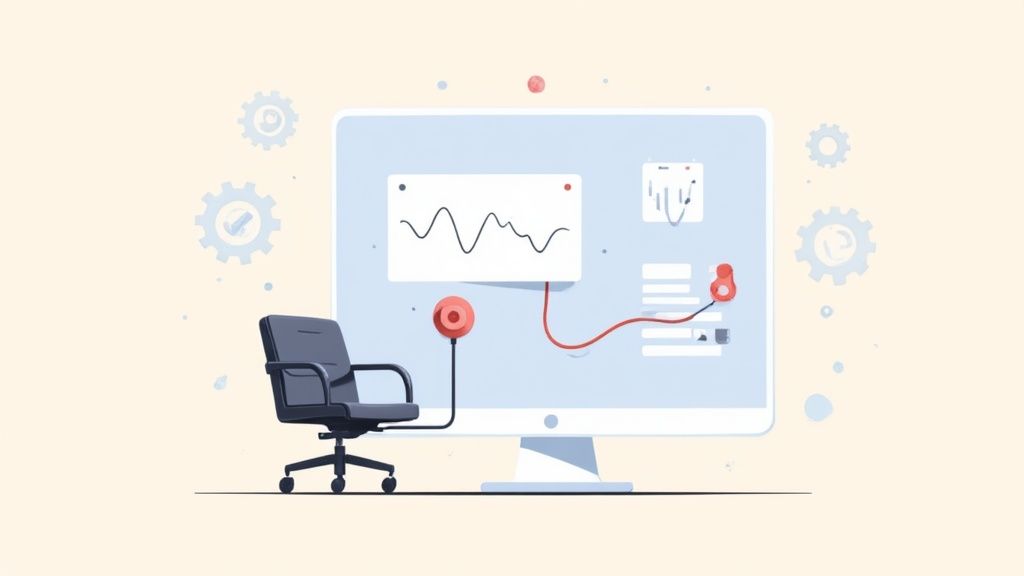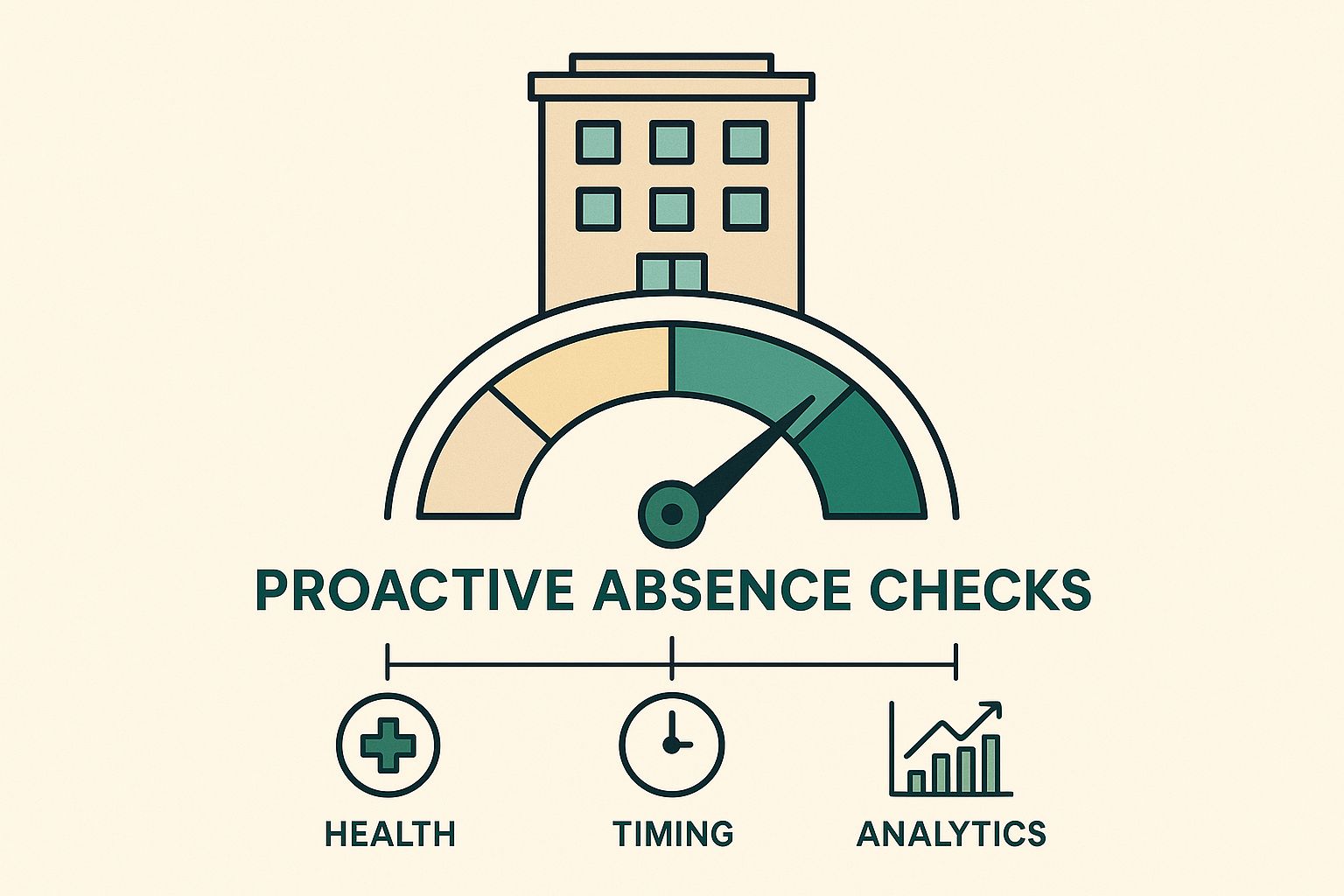
What Is Absence Management? Key Strategies for UK Businesses
Posted by Robin on 19 Oct, 2025 in
Absence management is the way businesses handle employee leave, look after their wellbeing, and keep the show on the road with minimal disruption. It’s not just about counting sick days; it’s a much broader approach to understanding why people are away from work so you can maintain a healthy, productive team.
What Is Absence Management Really
Let's ditch the textbook definition for a moment. At its heart, absence management is a critical function for keeping a business healthy. It directly links your team's wellbeing to productivity, company culture, and ultimately, your bottom line. It's really just a set of fair and consistent policies and procedures for handling employee time off.
Think of it less like a stern attendance register and more like your car's diagnostic system. Your car's dashboard doesn't just flash when the fuel is low. It flags potential engine trouble, low tyre pressure, and other little things that need attention before they cause a full-on breakdown.
In the same way, good absence management isn't just about noting who's off sick. It’s about digging into the 'why' behind the absence. This helps you spot underlying issues—like workplace stress, dipping morale, or a lack of support—before they grow into much bigger problems for both the individual and the business.
The True Scope of Absence Management
This proactive approach is built on a few key activities that all work together. It’s a continuous cycle of planning what to do, tracking what’s happening, supporting your people, and then analysing the results.
At its core, a solid absence management strategy is built on four pillars.
Here’s a quick rundown of what those pillars are and what they mean in day-to-day practice.
The Four Pillars of Absence Management
| Pillar | What It Means in Practice |
|---|---|
| Clear Policies | Having documented, easy-to-understand rules for everything from reporting sickness to requesting compassionate leave and what happens in a return-to-work chat. |
| Accurate Tracking | Using a reliable system (not a messy spreadsheet!) to record all types of leave. The data needs to be consistent, secure, and easy to pull up for analysis. |
| Supportive Interventions | Offering real support, like Employee Assistance Programmes (EAPs), and holding empathetic return-to-work conversations to help people get back on their feet. |
| Data Analysis | Regularly looking at absence data to spot patterns. Maybe one team has high absence rates, or perhaps sickness peaks at a certain time of year? These insights help you make smarter decisions. |
Getting these four elements right creates a supportive environment where everyone knows where they stand and feels accountable.
This infographic shows how these components work together, acting like that diagnostic system for your business by monitoring health, time, and data.

By keeping an eye on these indicators, a business can stay ahead of problems and prevent minor issues from turning into major headaches.
Why Managing Absence Is So Critical for Your Business
Going beyond the textbook definition of absence management quickly reveals why it’s so important. When you don't handle employee leave properly, it creates significant ripples across the entire business, affecting far more than just the empty desk of the person who's off. It's a strategic challenge with real, measurable costs.
When a team member is unexpectedly away, the most obvious cost is their lost productivity for that day. But that's just the tip of the iceberg. The indirect costs often add up to much, much more—these are the hidden expenses that slowly drain your resources and damage morale.
Think about it: the remaining team members have to pick up the slack. This can easily lead to burnout, lower engagement, and a higher chance of mistakes being made. In many cases, it means paying for overtime or scrambling to hire temporary cover, stretching your budget thin. And let's not forget the managers, who lose valuable time rearranging schedules and reassigning tasks, pulling them away from the strategic work that actually drives growth.
The Changing Landscape of Workplace Health
The need for a solid absence management strategy has become even more urgent in recent years. The post-pandemic workplace is dealing with a whole new set of health challenges that directly affect attendance, including a noticeable rise in long-term health conditions and mental health struggles across the UK workforce.
This shift isn't just anecdotal; the national statistics back it up. Over the past year, UK employees have taken an average of 9.4 sick days—that’s nearly two full working weeks. It's a sharp increase from the pre-pandemic average of just 5.8 days. This trend really shines a light on the growing complexity of supporting employee wellbeing while managing absence effectively. You can dig into more of this workplace absence data on cipd.org.
A proactive absence management system isn't a cost centre. It’s a powerful investment in your company's resilience, employee retention, and the supportive culture you want to build. It gives you the framework needed to navigate modern workplace health challenges with confidence.
It's More Than Just an HR Function
Treating absence as purely an HR issue misses the bigger picture entirely. It's a core business function that influences everything from your resource planning and project deadlines to your reputation as an employer.
When you manage it well, you're sending a clear message that you value your employees' wellbeing, which in turn builds loyalty and improves retention. It provides the data you need to plan staffing levels accurately, making sure you always have the right people in the right place to keep your customers happy. Ultimately, a great absence management system helps build a resilient and supportive culture where both the business and its people can truly thrive.
How to Build an Effective Absence Management Policy

A solid absence management policy is the absolute backbone of any fair and effective strategy. Think of it as a clear roadmap for both your employees and managers—it cuts through the noise, removes ambiguity, and makes sure everyone is treated the same way.
Without a clear policy, you’re just inviting confusion, inconsistent treatment, and even potential legal headaches. The goal here is to build a framework that supports your team's wellbeing while still being accountable to the needs of the business. It’s about detailing the practical steps everyone follows, which helps build trust and protect the organisation.
Laying the Groundwork with Clear Procedures
First things first: you need crystal-clear procedures for reporting an absence. Any grey areas here are a recipe for disaster. Your policy has to spell out exactly who an employee needs to contact, how they should do it (e.g., a phone call, not a last-minute text), and by what time on their first day off.
This initial phone call is more important than you might think. It’s not just about logging that someone is off; it’s the first chance for a manager to understand what’s going on and offer the right support from the get-go.
Beyond that first call, your policy needs to cover the different types of leave and how each one is handled. This includes planned time off like holidays but also the unplanned situations that life throws at us, such as:
- Sickness Absence: Detail the process for both short-term and long-term sickness. Crucially, state when a doctor's fit note is required.
- Compassionate Leave: Outline the specific circumstances where compassionate leave is granted and for how long.
- Parental and Dependant Leave: Clarify the entitlements for maternity, paternity, adoption, and emergency time off to care for dependants.
If you need a hand getting the leave policy itself down on paper, our article on how to simplify leave management with our template annual leave policy offers a fantastic starting point for documenting your rules.
Establishing Trigger Points and Support Mechanisms
A truly effective policy is proactive, not just reactive. This means building in trigger mechanisms that flag potential issues early, so you can step in and help. These aren’t meant to be punitive; they are simply prompts for a supportive conversation.
For instance, a trigger might be activated after an employee has 3 separate short-term absences within a 6-month period. When that happens, the next step isn’t a formal warning. It’s a structured, informal chat to see if there are underlying problems that need addressing.
A key part of this supportive approach is the return-to-work interview. This is a brief, informal chat with an employee on their first day back. It’s your chance to welcome them back, check they’re fit for work, and gently ask about their absence.
These interviews are invaluable. They show you care about your team’s health and that you take attendance seriously. They also create a consistent process that helps you spot patterns or underlying issues—like workplace stress or a recurring health problem—that might need adjustments or more support. Documenting these conversations consistently is absolutely crucial for fairness and compliance with UK law.
To help you pull this all together, here’s a quick checklist to make sure you’ve covered all the essential bases when creating or reviewing your policy.
Your Absence Management Policy Checklist
| Component | Key Consideration |
|---|---|
| Policy Scope | Who does the policy apply to? (e.g., all employees, specific departments) |
| Reporting Procedure | Who to contact, by what method, and by what time on day one? |
| Certification | When is a self-certification form needed? When is a doctor's fit note required? |
| Types of Leave | Are procedures for sickness, compassionate, and dependant leave clearly defined? |
| Return-to-Work Interviews | Is this a mandatory step? What should be discussed and documented? |
| Trigger Points | What specific patterns will prompt a supportive conversation or review? |
| Support Systems | What support is available? (e.g., Occupational Health, Employee Assistance Programmes) |
| Pay Entitlements | What are the rules for Statutory Sick Pay (SSP) and company sick pay? |
| Communication | How will the policy be communicated and made accessible to all staff? |
| Review Schedule | How often will the policy be reviewed and updated to remain compliant and effective? |
Making sure each of these points is clearly addressed will give you a robust, fair, and supportive framework that works for everyone.
Using Absence Data to Uncover Hidden Trends

Your attendance records hold more than just a list of sick days; they are a goldmine of insight just waiting to be tapped. By digging into this data, you can shift from simply reacting to absences to proactively understanding and addressing the real reasons behind them.
This process turns absence management from a dull administrative chore into a sharp strategic tool. Instead of just tallying up days off, you start asking much smarter questions. Are absences cropping up more often in one particular department? Do they spike during certain months of the year? Answering these questions gives you the hard evidence you need to build a wellbeing strategy that actually works.
To get the most out of your data, it helps to understand the principles of modern data analytics leveraging AI for insights.
Key Metrics Beyond Counting Days
Looking beyond the simple number of days an employee is absent can reveal much deeper patterns. To get a clearer picture of your workforce's health, successful organisations track a variety of different metrics.
- Absence Frequency Rate: This tells you how often employees are absent, not just for how long. A high frequency of short, unplanned absences can often be far more disruptive than one longer period of leave.
- The Bradford Factor: This is a formula that gives more weight to frequent, short-term absences, specifically to highlight these potentially disruptive patterns. A word of caution, though: it should be used as a trigger for a supportive conversation, never as a standalone disciplinary tool.
- Team or Departmental Patterns: Comparing absence rates across different teams can shine a light on localised issues. You might uncover problems like excessive workloads or management challenges that need to be addressed.
- Seasonal Trends: Spotting if absences peak at certain times of the year can help with resource planning and targeted wellbeing campaigns. For example, you might offer extra mental health support right after a gruelling project deadline.
Tracking these metrics allows you to spot problems bubbling under the surface before they escalate. For more on this, you might find our guide on https://blog.leavetrackapp.com/articles/the-importance-of-accurate-absence-tracking useful.
From Data to Actionable Insights
Good data tells a story. Let's say you discover your customer service department has a high rate of stress-related absences. Armed with this evidence, you can step in with targeted support—like resilience training or workload adjustments—instead of rolling out a generic, company-wide wellness programme that misses the mark entirely.
This data-driven approach is becoming more critical than ever. The UK’s sickness absence rate, measured as the percentage of working hours lost, hit a peak in 2022 at 2.6%. Although it dropped to 2% in 2024, it's still higher than the pre-pandemic rate of 1.9%. This data also hides a significant gap, with public sector rates at 2.9% compared to the private sector's 1.8%, showing that different environments face very different challenges.
By interpreting absence data correctly, you gain the proof you need to invest in initiatives that genuinely support employee health and wellbeing, leading to a more resilient and productive workforce.
How Software Can Streamline Your Absence Management
Let's be honest: managing absence with spreadsheets, paper forms, and endless email chains is an administrative nightmare. It’s a chaotic jumble of manual data entry, misplaced holiday requests, and a complete lack of real-time visibility. This old-school approach doesn’t just waste time; it’s a recipe for errors, inconsistent policy application, and frustrated employees.
Imagine trying to build a complex piece of furniture with a random assortment of tools and no instructions. You might get there in the end, but the process will be slow, painful, and the result is likely to be a bit wobbly. That's manual absence tracking in a nutshell. It technically works, but it's inefficient and unstable.
Absence management software is the purpose-built toolkit that replaces all that chaos with clarity and control.
Centralise and Automate Everything
The biggest change you'll see when adopting dedicated software is the move to a single, centralised system. Instead of vital information being scattered across spreadsheets on different computers or buried deep in someone's inbox, everything lives in one secure, accessible place.
This central hub becomes the undisputed source of truth for anything and everything leave-related.
- Simplified Requests: Employees can request holidays or report sickness through a simple interface, instantly seeing who else is off to avoid obvious clashes.
- Instant Approvals: Managers get a notification and can approve or deny requests with a single click, often directly from an email or even a Slack message.
- Automatic Record-Keeping: Every request, approval, and absence is logged automatically. This creates a clean, compliant audit trail without anyone having to lift a finger.
Here’s an example of how a clear digital planner gives you an at-a-glance view of team availability – something that’s practically impossible to replicate with spreadsheets.
This visual clarity means managers can make faster, better-informed decisions about resource planning and making sure projects are properly covered.
Gain Powerful, Real-Time Insights
Beyond just saving time on admin, good software turns your static absence records into a dynamic source of insight. With just a few clicks, you can pull reports to analyse trends, monitor Bradford Factor scores, or track leave balances across the entire company. You can learn more about the three key benefits of absence management software for SMEs in our detailed guide.
This isn't just about efficiency; it's about empowerment. A dedicated system gives you a clear, up-to-the-minute view of your workforce, which is crucial for strategic planning and maintaining productivity.
Ultimately, it closes the gap between having a good absence policy on paper and having the right tools to execute it fairly and effectively, every single day. It brings consistency, improves transparency, and frees up HR and managers to focus on supporting their people instead of chasing paperwork.
Building a Culture That Supports Employee Wellbeing
At the end of the day, even the slickest software and the most watertight policy will miss the mark if your company culture isn’t right. The human element is the final, essential piece of the puzzle. It’s what turns absence management from a box-ticking chore into a genuine commitment to your team’s health.
This cultural shift starts and finishes with your line managers. They’re on the front line, interacting with their teams every single day, and their behaviour sets the tone for the whole business.
A manager who greets a sickness call with a heavy sigh and a dose of suspicion fosters an atmosphere of fear. On the flip side, one who responds with genuine empathy builds a workplace where people feel safe enough to talk about health issues without being judged.
The Manager's Crucial Role
This is why training your managers isn’t just a ‘nice-to-have’ – it’s a cornerstone of proactive absence management. They need the skills to handle return-to-work conversations that are both supportive and effective. It's about moving past a simple "Are you fit to work?" to asking, "What support do you need to stay well at work?".
This proactive approach also means learning to spot the early warning signs of burnout and stress. To really build a supportive environment and tackle the root causes of absence, it’s worth looking into effective workplace stress reduction strategies. A manager who knows what to look for can step in early, stopping a small issue from snowballing into a long-term absence.
The real goal here is to shift the entire mindset of the business. Instead of just policing absence, the focus needs to be on proactively building a healthy, resilient, and engaged workforce where wellbeing is everyone's priority.
Knowing where to point people for help is another vital skill. Managers should be confident in guiding their staff towards the resources available to them, such as:
- Employee Assistance Programmes (EAPs): Confidential services that offer support for all sorts of personal or work-related problems.
- Occupational Health: Specialist medical advice on how health can affect work and what adjustments might help.
- Internal Mental Health First Aiders: Colleagues who are trained to listen and signpost people towards further support.
When managers are equipped with these skills, they transform into champions for wellbeing. They help create a culture where looking after your health is seen as a strength, not a weakness—and that directly leads to lower absence rates and a far more committed team.
Common Questions About Absence Management
When you get down to the practicalities of managing absence, a few common questions always seem to pop up. To help clear the air, we’ve tackled some of the most frequent queries from UK businesses, offering straightforward answers that build on what we’ve already covered.
What Is the Bradford Factor and Should We Use It?
The Bradford Factor is a mathematical formula (S² x D) that’s designed to highlight frequent, short-term absences over single, longer periods of sickness. The idea is that short, unplanned absences are often more disruptive to a business.
While it can be a handy tool for spotting potential patterns that need a closer look, it has to be handled with real care.
Think of it as a smoke alarm, not a verdict. The formula is just numbers; it doesn't understand context, like a disability, a chronic health condition, or a family crisis. Relying on it blindly to trigger disciplinary action feels punitive and can easily stray into discriminatory territory. It should only ever be used as a trigger for a supportive conversation, not an automated warning.
A return-to-work interview is a brief, informal chat with an employee on their first day back. Its purpose is twofold: to welcome them back and ensure they're well enough for their duties, and to understand the reason for their absence in a supportive way.
How Do We Fairly Manage Long-Term Sickness?
Managing a long-term absence is all about striking a balance between structure and compassion. The key is to maintain regular, supportive contact with the employee. This shouldn't feel like pressure; instead, agree on a communication schedule with them so they know when to expect a call.
Getting advice from an occupational health professional is often a smart move. They can give you a clearer picture of the employee's prognosis and help identify any reasonable adjustments you might need to make for their return. Often, exploring a phased return to work can be a brilliant way to ease someone back into their role.
Throughout the entire process, meticulous and consistent documentation is non-negotiable. This isn't just bureaucracy—it's how you ensure you're acting fairly and staying on the right side of UK employment law, especially the Equality Act 2010.
Ready to replace chaotic spreadsheets and gain full visibility over staff leave? Leavetrack centralises all your absence data, simplifies requests and approvals, and provides instant insights to help you build a more supportive and productive workplace. Discover how much time you could save by visiting https://leavetrackapp.com.
